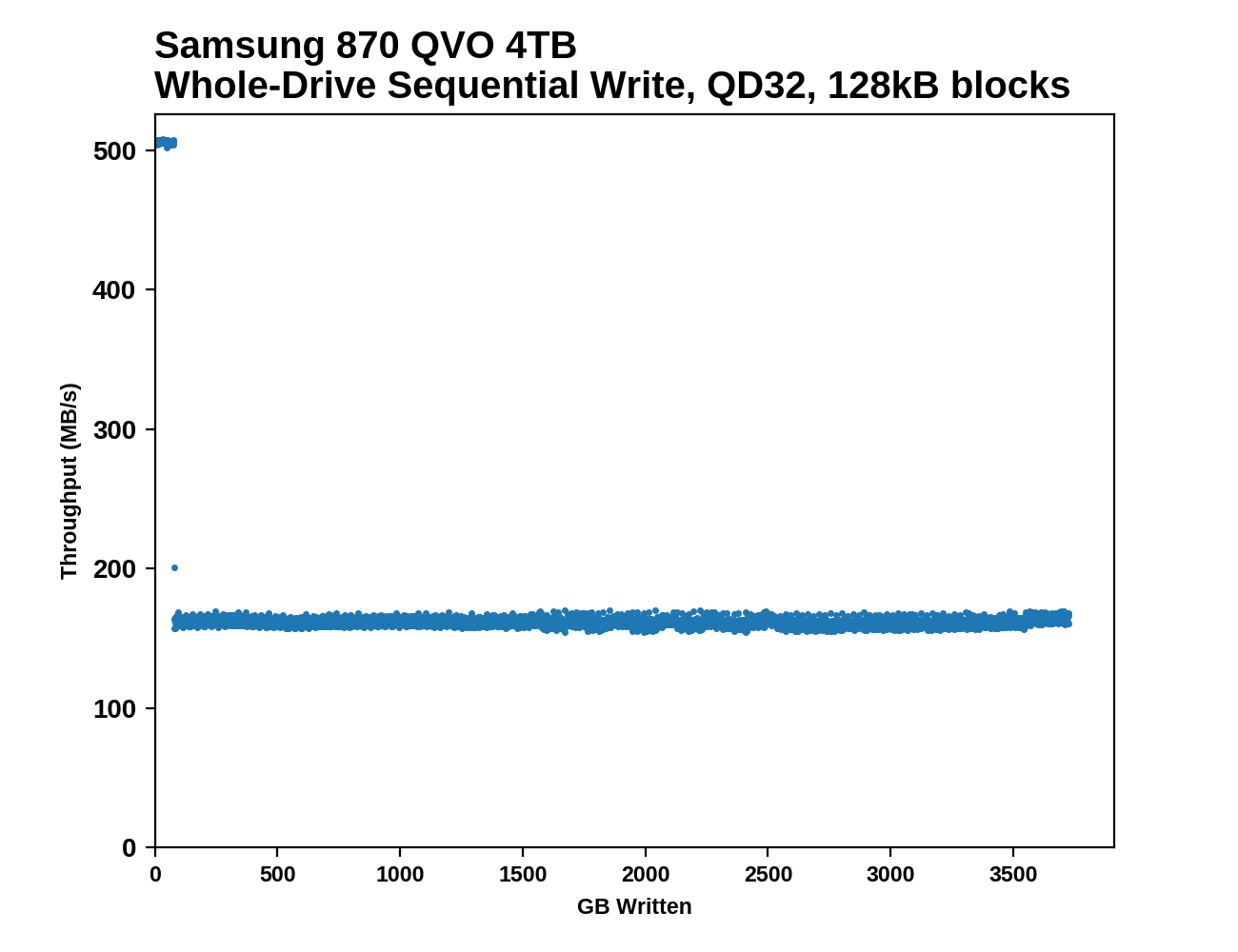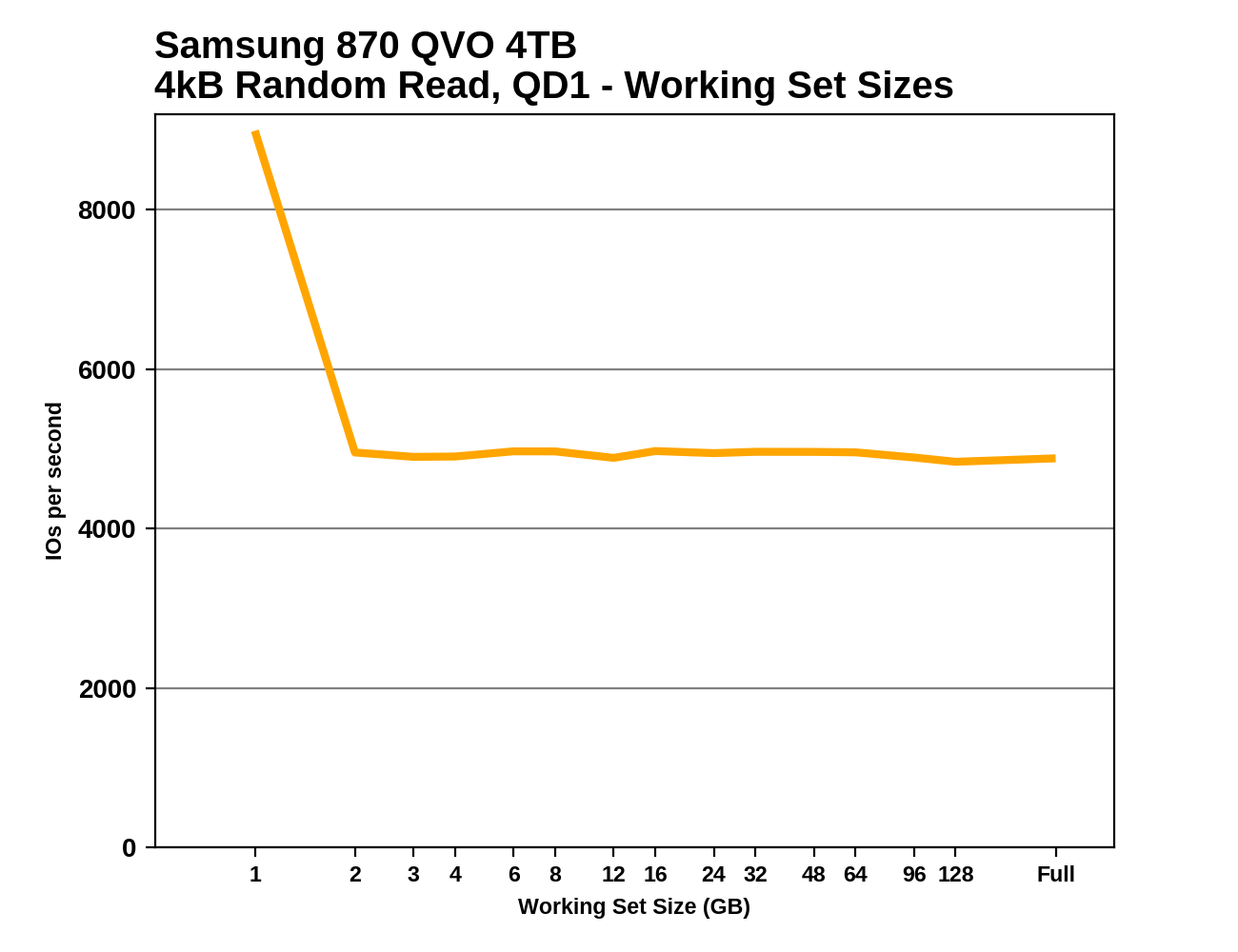The Samsung 870 QVO (1TB & 4TB) SSD Review: QLC Refreshed
by Billy Tallis on June 30, 2020 11:40 AM ESTWhole-Drive Fill
This test starts with a freshly-erased drive and fills it with 128kB sequential writes at queue depth 32, recording the write speed for each 1GB segment. This test is not representative of any ordinary client/consumer usage pattern, but it does allow us to observe transitions in the drive's behavior as it fills up. This can allow us to estimate the size of any SLC write cache, and get a sense for how much performance remains on the rare occasions where real-world usage keeps writing data after filling the cache.
 |
|||||||||
The SLC caches on the 870 QVOs run out right on schedule, at 42 GB and 78 GB. Write performance drops precipitously but is stable thereafter, for the rest of the drive fill process. This behavior hasn't changed meaningfully from the 860 QVO.
 |
|||||||||
| Average Throughput for last 16 GB | Overall Average Throughput | ||||||||
The 870 QVO turns in scores that are very similar to its predecessor. The 1TB model averages similar write performance to a hard drive, albeit with very different performance characteristics along the way. The 4TB model manages to stay ahead of the hard drive's write performance for pretty much the entire run. Both capacities of QLC drives offer a mere fraction of the post-cache write speed of mainstream TLC drives, and even the 2TB DRAMless TLC drive offers much better sequential write performance for almost all of the test duration.
Working Set Size
Most mainstream SSDs have enough DRAM to store the entire mapping table that translates logical block addresses into physical flash memory addresses. DRAMless drives only have small buffers to cache a portion of this mapping information. Some NVMe SSDs support the Host Memory Buffer feature and can borrow a piece of the host system's DRAM for this cache rather needing lots of on-controller memory.
When accessing a logical block whose mapping is not cached, the drive needs to read the mapping from the full table stored on the flash memory before it can read the user data stored at that logical block. This adds extra latency to read operations and in the worst case may double random read latency.
We can see the effects of the size of any mapping buffer by performing random reads from different sized portions of the drive. When performing random reads from a small slice of the drive, we expect the mappings to all fit in the cache, and when performing random reads from the entire drive, we expect mostly cache misses.
When performing this test on mainstream drives with a full-sized DRAM cache, we expect performance to be generally constant regardless of the working set size, or for performance to drop only slightly as the working set size increases.
 |
|||||||||
The 870 QVO clearly has improved read latency over its predecessors, and that's enough for the 1TB 870 to slightly outperform the ADATA SU750, a DRAMless TLC drive. The 4TB 870 QVO also shows a new behavior, with excellent random read performance at the very beginning of the test—better even that the TLC-based 860 EVOs. It looks like this test may have caught some data that was still being served from the SLC cache. Otherwise, the 870 QVOs don't care much about data locality for random reads, unlike many drives with limited or no DRAM cache.










64 Comments
View All Comments
Jorgp2 - Tuesday, June 30, 2020 - link
That HDD is also CMR.A normal HDD would perform much better.
Daeros - Tuesday, June 30, 2020 - link
CMR is Conventional Magnetic Recording - you're thinking of SMR (Shingled Magnetic Recording), which this drive does not use.Sivar - Tuesday, June 30, 2020 - link
Valid argument in 2020: "I replaced my 1TB SSD with a 7200RPM hard drive to reduce write latency, improve durability, and reduce costs by half."ballsystemlord - Tuesday, June 30, 2020 - link
Spelling and grammar errors:"All of the QLC drives require substantially more energy to complete The Destroyer than mainstream TLC drives, and one of the DRAMless TLC drives comes out wa"
You were saying?
"Some of the big differences in write speed shown for the 1TB QVOs here may be an artifact of this test's size and duration, but even so it is clear that the smallest QV"
You were saying?
zachj - Tuesday, June 30, 2020 - link
Why not compare to the 4TB Western Digital Red WDS400T1R0A SATA SSD? That would seem to be a somewhat reasonable comparison...Billy Tallis - Tuesday, June 30, 2020 - link
The WD Red SSD is basically the WD Blue SSD with SLC caching turned off, which makes it a less relevant point of comparison. And I don't have a 4TB sample of either of those products.zachj - Tuesday, June 30, 2020 - link
The WD Red ssd has an endurance rating (terabytes written) literally 4x higher--2500 versus 600--than the WD Blue drive. I don't have any data on which to disagree with your assertion that red and blue drives are mechanically identical but I think the difference in endurance is highly relevant given that one of two major pitfalls of QLC drives is endurance...NoSoMo - Wednesday, July 1, 2020 - link
As tests have shown the endurance rating is for the most part hot air -- SSDs can easily exceed that threshold many times over. Sure you can pay more in a drive to get a warranty, but you can also just buy the same drive w/ cache for less....... Warranties after all are BIG business with profits in the 80+ percentile range.Oxford Guy - Tuesday, June 30, 2020 - link
QLC is the kind of product that companies like and consumers shouldn't.It's one of the instances where the product serves the seller more than the buyer.
Another example is the fiction known as the contemporary console (really a PC with a rubbish walled garden so everyone has to pay extra for extra drawbacks).
eek2121 - Wednesday, July 1, 2020 - link
It’s mostly due to the Samsung tax. I expect that, with some effort, it is possible to put out a decent performing 4TB QLC drive for $200. However, that means broad adoption of QLC. Thus far it seems TLC is the favorite.